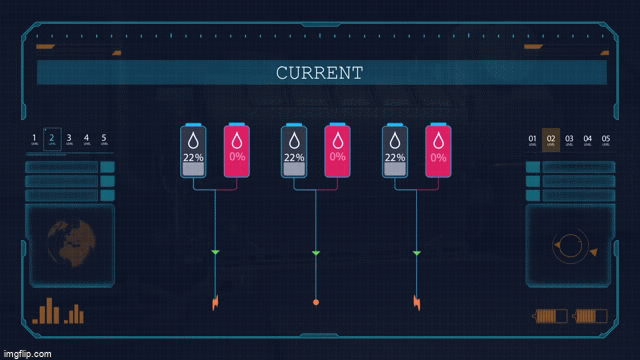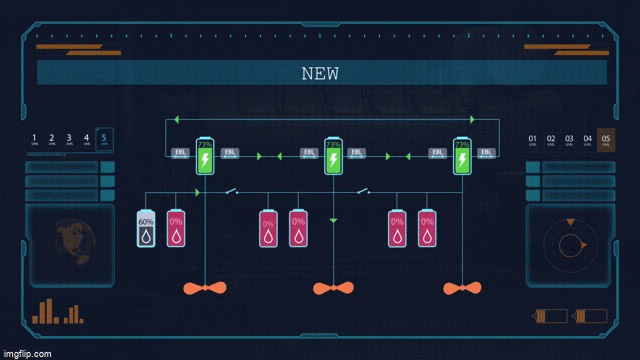The Big Friendly Hybrid Giant
Summary - The North Sea Giant, a Norwegian offshore construction vessel, is the first DNV class-approved ‘hybrid’ DP3 vessel with three batteries on-board that have a total capacity of 2.034 kWh. The batteries have been installed in an upgrade and serve the purpose of spinning reserve, peak shaving and load leveling. Since then, fuel consumption is reduced in all operational modes with over 2 million liters of diesel per year, saving up to 30% fuel. The crew is very pleased with the upgrade as the system has increased redundancy of the DP vessel and added to an all-round sense of safety.
My Norwegian is a little rusty but I believe the title of the video says: “How the North Sea Giant saves 2 million liters of diesel every year.” To the right are the specifications of the vessel.
About the North Sea Giant
A marvel of engineering
Built in 2011 by North Sea Shipping AS, winner of the Offshore Support Journal’s “vessel of the year award” and touted as “the world’s most advanced offshore construction vessel”, she has certainly earned her rank in the hall of fame.
A number of features make her special, not in the least a sophisticated DP3 dynamic positioning system and Voith-Schneider propellers that allow her to maintain position with high accuracy in the most challenging conditions. Arnstein Eknes, Segment Director, Special Ships at DNV GL remarks: “This is necessary because of the sophisticated subsea installation and maintenance work the ship has to perform, such as pipe-laying, installing subsea stations, or hyperbaric wet welding.” To make sure no technical failure on board will disrupt this work, the ship has triple redundant power systems, including a total of six diesel generators.
In dynamic positioning (DP) it is required for these redundant power groups to be fully segregated, explains Henning Revne, Technical Manager at North Sea Shipping. “That is the challenge on these vessels: since you don’t have a connection between the redundancy zones, you need to have a power source within each group, which means that you run multiple diesel engines - one or more in each group - at the same time.” In the ship’s original configuration, this meant that at least two or three of the diesel generators would be running constantly during subsea operations to provide the necessary backup power, consuming large amounts of fuel.
That is where the batteries come in.
The DNV battery-class upgrade
Around 2017, North Sea Shipping decided to upgrade the Giant with batteries in order to improve redundancy and decrease fuel consumption. The upgrade coincided with the development of a new class notation by DNV that accounts for the advanced capabilities of enhanced reliability and closed-bus-tested dynamic positioning systems. North Sea Giant was the first ship to obtain the DynPos AUTRO(ER)(CBT) notation, which confirms the vessel’s ability to perform complex operations safely with assured power available at all times, even in rare case of two successive failures.
Following careful planning, the retrofit was carried out Aibel-Storesund shipyard. Wärtsilä was the system integrator and had overall responsibility for the delivery of the hybrid system. Corvus Energy supplied the batteries, and Power Electronics supplied the crucial switchover system, so-called open bus-tie breakers installed between the switchboard sections. These bus breakers are normally open. “The AC power switchboard is segregated but the systems are tied together on the DC side with electronic bus-link breakers, which respond much faster than mechanical ones, ensuring practically interruption-free failover,” explains Henning Revne. “These switches were custom-developed for this project. Our ship is pioneering this technology.”
As an added benefit that greatly enhances the competitiveness of the ship, North Sea Giant can perform the same operations as before with the same redundancy ‒ with only one engine running, highlights Revne. “Our customer, the charterer, benefits enormously because they pay the fuel bill. We also save about one third of the diesel engine running hours, which substantially reduces maintenance costs. Our company benefits from that through lower OPEX.”
What’s even more unbelievable, the switchover is so smooth that nobody on-board will notice it except the watch officer when a notification message appears on the display on the bridge. Truly incredible. So how does it work exactly?
How does a hybrid vessel work?
Current - Diesel Electric
A typical diesel-electric vessel works as follows. An internal combustion engine directly powers a generator (dynamo), turning mechanical energy into electrical energy. The electrical energy is routed to a switchboard, from which it is diverted to on-board systems that demand power. The power demand is determined by the energy consumers, for instance propulsion or deck equipment. If there is a sudden increase in power demand, the combustion engines will have to quickly provide this energy. There is a limit to how fast energy can be provided by diesel engines, which could result in blackouts on the vessel if power demand is limited by the power management system.
New - Hybrid
A hybrid vessel has the same type of equipment on-board, that is the combustion engines, generators and switchboard. There is however a battery system added, which is connect to the switchboard. The battery system stores electric energy during normal operation. Upon a sudden failure of the diesel engine, or above a certain limit, the battery system can take over some or all power production, ensuring that the vessel can uninterruptedly continue its duty. Battery systems can generally provide virtually instantaneous power, which adds to the flexibility of the energy system in case of an emergency, increasing redundancy.
+ Battery Functions
Generally speaking there are three types of functions a battery system can fulfill on-board a vessel:
Load leveling
Peak shaving
Spinning reserve
Load leveling and peak shaving are similar, as in that they moderate the load to a certain level. Load leveling makes sure the generator load remains constant continuously, while peak shaving only keeps the engine load within certain boundaries. This function potentially reduces the need to start up an additional engine. All functions save fuel, though it is usually the case that for larger vessels with larger generators spinning reserve applications preserve more fuel because one or more generators can be shut down. Running your generators more efficiently and having to use them less results in significant cost and fuel saving benefits.

What are the benefits of hybrid power?
From a technical standpoint, it can be argued that a hybrid diesel-electric system outperforms any other regular diesel-electric system, in particular due to improved redundancy, load optimization and cost reduction, and of emission reduction due to fuel savings.
+ Improved redundancy with less engines
In the event of an engine failure during DP, a switchover mechanism must instantly bring in one of the redundancy groups until another generator has been started up and reached full operating speed. Batteries starkly outperform diesel engines in this respect, as they can instantly provide power in case of a failure. In practice, this simply means less engines are required to serve as backup during DP. In this case the battery system acts as ‘spinning reserve’ in case of an emergency.
According to Mr Revne, the North Sea Giant already uses fewer engines in all types of mode. “We now manage 80 per cent of the DP-operations with only one engine. The batteries have improved the redundancy of the operations since battery power is always available. So, the power supply is now safer and more reliable. Moreover, on top of this, we have already seen quite significant fuel savings and emission reductions.”
+ Running on optimal load minimizes operating costs and maintenance
For hybrid DP3 class vessels such as the North Sea Giant, the amount of engines running is reduced from three to just one. At the same time, that single engine will run at a higher efficiency and consume substantially less fuel compared to three engines running at lower load. This is generally referred to as peak shaving or load levelling.
In technical terms the three energy storage systems, coupled to independent AC grid sections, are now connected by a DC link to create a common DC power source for each AC grid section. This allows the North Sea Giant to run only one engine on optimal load rather than three engines on low load. The power produced can then be distributed by the single engine through the DC grid.
+ Fuel savings = reduced emissions
Once batteries are fully charged, they are ready to supply power at any moment without consuming energy while idle, as opposed to generators running in standby mode. The significant fuel savings of 30% in the case of the Giant translate directly into reduced emissions.
“We have measured fuel savings of up to 40% in DP-mode. For more reliable figures we need to measure the consumption over a longer time period. It looks promising since our aim was an overall annual fuel reduction of 30%. The reduced running hours will also lead to lower maintenance costs. This was a conversion case, but for a newbuild you could even reduce the number of engines,” concludes Mr Revne on his recommendation for other owners to go for a hybrid solution.
Hallvard Klepsvik, North Sea Shipping CEO, said: “For us, it is important to reduce environmental emissions and modernize the vessel to make it more competitive. Also, with a more efficient vessel, we will save fuel expenses. The estimated reduction in emissions is 5,500 tons of CO2, 30 tons of NOx and 1,200 kg SOx per year.
What are the challenges of hybrid power?
Retrofitting, costs and fire safety
Some modifications were necessary on board to make space for three separate battery sets. “Space was a challenge,” says Sveinung Økland. “But the vessel had been designed to allow the installation of an enlarged moon pool, which was never done. This space was adjacent to the existing switchboard room, so we built the three battery rooms in that space. The remaining components were fitted into the existing switchboard rooms. We also had to replace the existing transformers with new ones because we didn’t have space for an additional one.”
In addition to challenges in the installation, the batteries are expensive, ranging in price from €400 per kWh for newbuilds and €800 per kWh for retrofit according to MAN. In addition to costs and installation challenges, fire safety due to thermal runaway of the batteries remains a point of concern. Because the amount of experience with these types of systems is limited, extra attention should be given to fire suppression systems which results in additional costs. Although improvements in battery technology in the future - most noticeably solid-state lithium - will improve (fire) safety, offshore remains a challenging environment to operate in.
References & Further Reading
Mr. Sustainability - Insights on Batteries
DNV - Instant, reliable battery power at all times
Offshore Energy - ‘North Sea Giant’ to become world’s first DP3 hybrid vessel
Corvus Energy - The first vessel with class-approved ESS for DP3
Wärtsilä - Hybrid solution upgrade brings significant fuel savings for offshore vessel
SPBES - Safety Concerns for Hybrid Vessels




